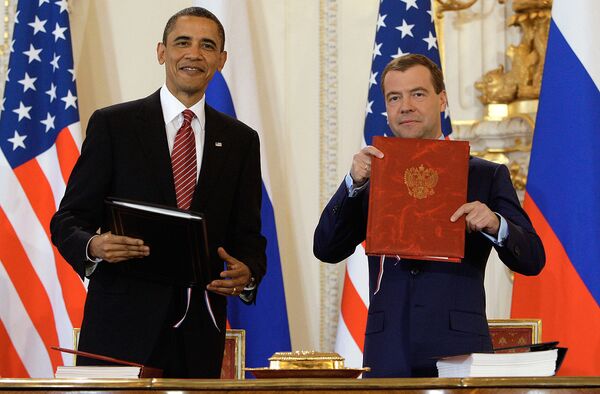The new START (Strategic Arms Reduction Treaty) bilateral nuclear arms reduction treaty between Russia and the United States was signed by Presidents Dmitry Medvedev and Barack Obama on April 8, 2010 in Prague, the capital of the Czech Republic.
The New START Treaty is organized into three, increasingly detailed, tiers. The first is the 12-page Treaty text itself. The second tier consists of a 138-page Protocol to the Treaty, which contains additional rights and obligations associated with Treaty provisions. These two documents detail the basic rights and obligations. The third tier consists of Technical Annexes to the Protocol.
The Protocol to the Treaty defines the Treaty's terminology and sets out procedures for observing the Treaty and monitoring compliance.
Although the bulk of the document is aimed at specialists, Part One entitled Terms and Their Definitions is very interesting. In effect, this is the only current legal set of terms regarding strategic nuclear arms.
First, a few words about the term "ICBM base." The new START treaty sets no limits on the bases for land-mobile intercontinental ballistic missile (ICBM) systems of the RT-2PM Topol (SS-25 Sickle), RT-2UTTKh Topol-M (SS-27 Sickle B) and RS-24 Yars (SS-X-29) classes.
Under Article IV of the Treaty, each party can only base deployed ICBM launchers at ICBM bases.
Under the Protocol, the term "ICBM base" means: (a) for mobile ICBM launchers, an area in which one or more basing areas and one associated maintenance facility are located.
Unlike the START-I treaty, this definition says nothing about the size of such an area, the number of basing areas, or the number of ICBM launchers which can be deployed simultaneously outside these areas.
And now a few words about the definitions of the nuclear triad's main elements.
The term "intercontinental ballistic missile" or "ICBM" still means a land-based ballistic missile with a range of at least 5,500 kilometers. This is the shortest distance between Russian territory and the continental United States, excluding Alaska.
The term "heavy bomber" means a bomber of any type that satisfies either of the following criteria: (a) its range is greater than 8,000 kilometers; or (b) it is equipped for long-range nuclear air-launched cruise missiles (ALCMs) with a range in excess of 600 kilometers.
The bomber's 8,000-km range allows it to take off from Russian territory, to hit a target on U.S. territory (or vice versa) and to return to its home base with no more than one in-flight refueling. This definition was first coined during the initial Soviet-U.S. strategic arms limitation talks (SALT) in the 1970s.
At that time, the parties disagreed on the Tupolev Tu-22M3 Backfire bomber which has a range of 7,000 km. The United States insisted that the bomber be listed as a heavy bomber and agreed not to consider it as such after the U.S.S.R. pledged not to equip the Tu-22M3 with aerial refueling systems and not to use it to launch ALCMs with a range above 600 kilometers.
Under the Treaty, the term "submarine-launched ballistic missile" or "SLBM" means a ballistic missile with a range in excess of 600 kilometers of any type that is contained in, or launched from, a submarine.
This reduction in missile range is absolutely logical because concealed and maneuverable submarines can approach the coast and receive strategic capabilities even when equipped with missiles having a shorter range than ICBMs.
Although long-range cruise missiles have the same capabilities, this and previous START treaties give strategic-arms status to air-launched cruise missiles alone. The deployment of sea-launched cruise missiles (SLCMs) is currently limited by a 1991 Soviet-U.S. agreement to remove all tactical nuclear weapons from naval surface ships and submarines.
This definition covered Soviet S-10 Granat (SS-N-21 Sampson) and U.S. BGM-109A Tomahawk nuclear-tipped long-range cruise missiles.
Although conventional modern SLCMs can play an important strategic role, numerous Russian proposals on limiting this class of naval weapons have not been supported to date.
The opinions expressed in this article are the author's and do not necessarily represent those of RIA Novosti.
MOSCOW. (RIA Novosti military commentator Ilya Kramnik)

